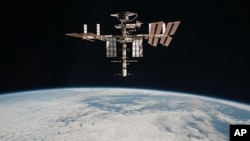The International Space Station is not simply an outpost for astronauts. It is a premiere science laboratory. Studies on the spacelab are helping scientists develop a potential vaccine for an illness that kills thousands of people annually.
Salmonella is a potentially deadly food-borne bacterium that plagues millions of people each year, making them sick with fever, stomach cramps, vomiting and diarrhea. But infection with salmonella does not just induce misery. The World Health Organization says salmonellosis - and the dehydration that comes with it - leads to thousands of deaths annually, with the very young and elderly most at risk.
While rehydration and antibiotics can treat most cases of salmonella, scientists around the world have long sought a protective vaccine. A NASA official recently told lawmakers in Washington that research in space has led to a potential breakthrough.
Bill Gerstenmaier, NASA's associate administrator for human exploration and operations, said some of the work conducted on the International Space Station is making its way to the U.S. Food and Drug Administration, or FDA.
"We've done research on salmonella and we've been able to develop essentially a strain of salmonella that's strong enough to cause the immune system to react but not strong enough to give you the disease, so that's essentially a vaccine. That's about ready to go into FDA trial," Gerstenmaier said.
Gerstenmaier explained that scientists have tested the potential vaccine on small organisms - namely worms in orbit - to get it through the first phases of the FDA process. He said the potential vaccine could go into FDA trials soon.
Julie Robinson, the chief scientist for the International Space Station Program, told VOA that it is difficult to predict when human trials could begin.
"The challenge we always have with any kind of medical development like this is getting it, as scientists say, from 'bench to bedside,'" she said.
She said scientists are preparing to apply to the FDA for Investigational New Drug certification, which is required before clinical testing on a small group of people. Robinson said additional testing on the ground might first be necessary.
Scientists began conducting this salmonella research on the space station in 2007. Robinson says researchers are not certain of the reason, but salmonella behaves differently in microgravity.
"One idea that is out there is that in your intestines, you have a lot of pockets and you have essentially what's called 'a low shear environment' where there's not a lot of fluid forces rubbing against the bacteria at that small scale. So it may be that what they [salmonella bacteria] experience in spaceflight also triggers something that tells the organism 'oh, you're in a good place to start multiplying,'" Robinson said.
Robinson added that studies onboard the space station have also led to advances in battling pneumonia and deadly infections.
NASA astronaut Cady Coleman has worked on such science experiments aboard the orbiting outpost. Coleman, who has degrees in chemistry, polymer science and engineering, explained the benefits of working in microgravity.
"Up in space, some of those viruses - that really important part - is so much more active and is so much easier to see that we can understand what is the active part of this virus," Coleman said.
And that makes it easier to figure out what might work in a treatment.
The U.S. space agency says more than 1,250 investigations involving researchers from more than 60 countries were performed during the first 28 space station missions.
NASA and its partners have agreed to fund the orbiting space lab until at least 2020.
News
Salmonella Research in Space Yields Breakthroughs on Earth







